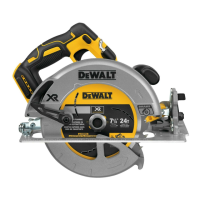battery packs include a fuel gauge which
consists of three green LED lights that indicate the level of
charge remaining in the batterypack.
To actuate the fuel gauge, press and hold the fuel gauge button
32
. A combination of the three green LED lights will illuminate
designating the level of charge left. When the level of charge
in the battery is below the usable limit, the fuel gauge will not
illuminate and the battery will need to berecharged.
NOTE: The fuel gauge is only an indication of the charge left on
the battery pack. It does not indicate tool functionality and is
subject to variation based on product components, temperature
and end-userapplication.
Changing Blades
To Install the Blade (Fig. C–E)
1. Remove thebattery.
2. Using the lower guard lever
6
, retract the lower blade
guard
7
and place blade on saw spindle against the inner
clamp washer
17
, making sure that the blade will rotate
in the proper direction (the direction of the rotation arrow
on the saw blade and the teeth must point in the same
direction as the direction of rotation arrow on the saw). Do
not assume that the printing on the blade will always be
facing you when properly installed. When retracting the
lower blade guard to install the blade, check the condition
and operation of the lower blade guard to assure that it is
working properly. Make sure it moves freely and does not
touch the blade or any other part, in all angles and depths
ofcut.
3. Place outer clamp washer
16
on saw spindle with the
beveled edge facing out. Make sure the 30 mm diameter on
the blade side of the clamp fits into the 30 mm hole in the
saw blade to ensure centering of theblade.
4. Thread the blade clamping screw
8
onto the saw spindle
by hand (screw has right-hand threads and must be turned
clockwise to tighten).
5. Depress the blade lock
11
while turning the saw spindle
with the blade wrench
14
stored underneath the battery
compartment, until the blade lock engages and the blade
stopsrotating.
6. Tighten the blade clamping screw firmly with the
bladewrench.
NOTICE: Never engage the blade lock while saw is
running, or engage in an effort to stop the tool. Never
turn the saw on while the blade lock is engaged. Serious
damage to your saw willresult.
To Replace the blade (Fig. C, D)
1. Remove thebattery.
2. To loosen the blade clamping screw
8
, depress the blade
lock
11
and turn the saw spindle with the blade wrench
14
, stored underneath the battery compartment, until
the blade lock engages and the blade stops rotating.
With the blade lock engaged, turn the blade clamping
screw counterclockwise with the blade wrench (screw has
right-hand threads and must be turned counterclockwise
toloosen).
3. Remove the blade clamping screw
8
and outer clamp
washer
16
. Remove oldblade.
4. Clean any sawdust that may have accumulated in the
guard or clamp washer area and check the condition and
operation of the lower blade guard as previously outlined.
Do not lubricate thisarea.
5. Select the proper blade for the application (refer to Blades).
Always use blades that are the correct size (diameter)
with the proper size and shape center hole for mounting
on the saw spindle. Always assure that the maximum
recommended speed (rpm) on the saw blade meets or
exceeds the speed (rpm) of thesaw.
6. Follow steps 1 through 5 under To Install the Blade, making
sure that the blade will rotate in the properdirection.
Lower Blade Guard
WARNING: The lower blade guard is a safety feature
that reduces the risk of serious personal injury. Never
use the saw if the lower guard is missing, damaged,
misassembled or not working properly. Do not rely
on the lower blade guard to protect you under all
circumstances. Your safety depends on following
all warnings and precautions as well as proper
operation of the saw. Check the lower blade guard
for proper closing before each use. If the lower blade
guard is missing or not working properly, have the
saw serviced before using. To assure product safety
and reliability, repair, maintenance and adjustment
should be performed by an authorized service center
or other qualified service organization, always using
identical replacementparts.
Checking the Lower Guard (Fig. A)
1. Turn tool off and disconnect from powersupply.
2. Rotate the lower guard lever (Fig.A,
6
) from the fully closed
position to the fully openposition.
3. Release the lever and observe the guard
7
return to the
fully closedposition.
The tool should be serviced by a qualified service center if it:
• fails to return to the fully closed position,
• moves intermittently or slowly, or
• contacts the blade or any part of the tool in all angles and
depth ofcut.
Blades
WARNING: To minimize the risk of eye injury, always
use eye protection. Carbide is a hard but brittle material.
Foreign objects in the workpiece such as wire or nails
can cause tips to crack or break. Only operate saw when
proper saw blade guard is in place. Mount blade securely
in proper rotation before using, and always use a clean,
sharpblade.
WARNING: Do not cut metal, plastic, concrete, masonry
or fiber cement materials with thissaw.

